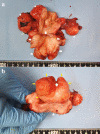Uterine Cervical Adenosarcoma Showing an Endophytic Growth Pattern
- PMID: 36128067
- PMCID: PMC9451560
- DOI: 10.14740/jmc3952
Uterine Cervical Adenosarcoma Showing an Endophytic Growth Pattern
Abstract
Adenosarcomas are biphasic neoplasms that usually originate in the uterine corpus and comprise a benign epithelial component and a malignant stromal component. Uterine adenosarcomas typically present with abnormal genital bleeding, an enlarged uterus, and a tumor that protrudes into the endometrial cavity. These tumors rarely protrude through the cervical os and are often misdiagnosed as cervical polyps. We present the case of a patient with cervical adenosarcoma with characteristics different from those reported in previous cases. This tumor showed endophytic growth, which is rare in cervical adenosarcomas. No watery discharge or obvious genital bleeding was noted. Although the tumor measured 4 cm, vaginal bleeding was noted only once at 6 months before diagnosis and was in the form of faint brown discharge.
Keywords: Adenosarcoma; Endophytic growth; Uterine cervix.
Copyright 2022, Lin-Satoi et al.
Conflict of interest statement
None to declare.
Figures








References
-
- Harlow BL, Weiss NS, Lofton S. The epidemiology of sarcomas of the uterus. J Natl Cancer Inst. 1986;76(3):399–402. - PubMed
Publication types
LinkOut - more resources
Full Text Sources
